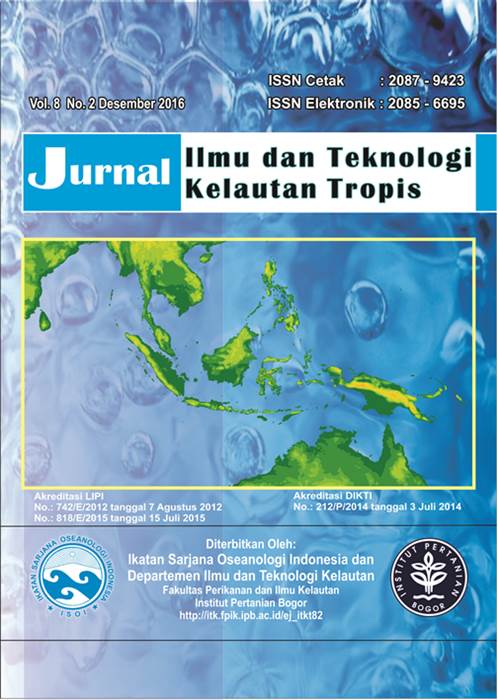COMPOSITION AND ANTIBACTERIAL ACTIVITIES OF MARINE SPONGES FROM DIFFERENT SEAGRASS ECOSYSTEMS IN KEPULAUAN SERIBU WATERS, JAKARTA
Abstract
A seagrass ecosystem has high productivity that supports many species of associated invertebrates, including sponges. However, seagrass beds with different habitat condition, including seagrass species composition and architectural morphotypes could affect the associative sponge in the ecosystem. This study is aimed to find out about sponge species composition in different seagrass beds. The observation was conducted in two seagrass ecosystems at the east (site 1) and at the southeast (site 2) of Pramuka Island, Kepulauan Seribu, near Jakarta Bay, Indonesia. The Belt Transect was used to assess the density of sponges on the seagrass ecosystem, which was placed parallel to the coastline. The sponges species has higher number at the east than the southeast, with both sites was dominated by Spirastrella sp. and Agelas conifera. Correspondence Analysis (CA) results showed that sponges community has close interaction with seagrass abundance especially Cymodocea rotundata and Enhalus acoroides and architectural characteristic (patchily or continues meadows). Antibacterial assay of sponges tissue showed that only 7 sponge species has activity against targeting bacteria. The CA results also showed that sponge antibacterial activity was not correlated with seagrass species, with low bactericide and bacteriastatic activities. The implication of this result showed that sponges community can grow up at seagrass ecosystem eventhough their potential secondary metabolite activities is very low probably due to lack of stimulus mechanisms in the environment.
Authors
IsmetM. S., BengenD. G., RadjasaO. K., & KawaroeM. (2017). COMPOSITION AND ANTIBACTERIAL ACTIVITIES OF MARINE SPONGES FROM DIFFERENT SEAGRASS ECOSYSTEMS IN KEPULAUAN SERIBU WATERS, JAKARTA. Jurnal Ilmu Dan Teknologi Kelautan Tropis, 8(2), 729-745. https://doi.org/10.29244/jitkt.v8i2.15838
The author submitting the manuscript must understand and agree that the copyright of the article manuscript must be submitted/transferred to the Jurnal Ilmu dan Teknologi Kelautan Tropis. This work is licensed under the Creative Commons Attribution-ShareAlike 4.0 (CC BY-SA) International License in which the Author and Reader can copy and redistribute the material in any media or format, and remix, modify and build material for any purpose, but they must provide appropriate credit (citing articles or content), provide a link to the license, and indicate whether there is a change. If you mix, change, or create material, you must distribute your contribution under the same license as the original.

